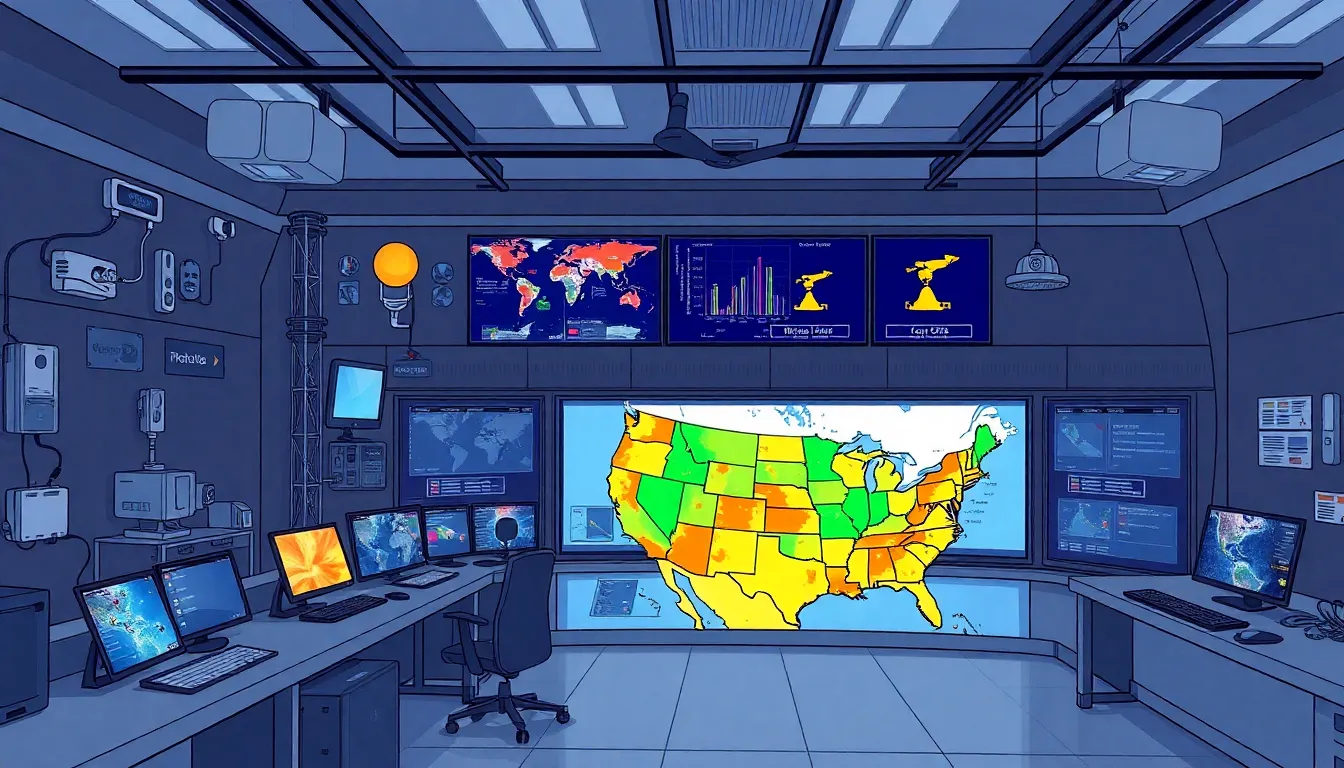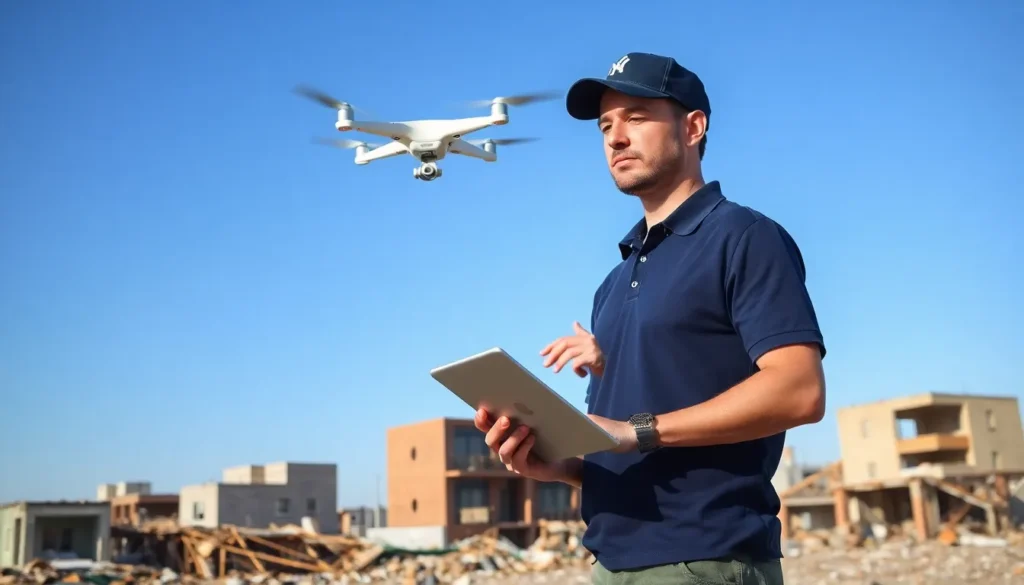In a world where disasters can strike faster than a caffeine-fueled squirrel, technology stands as humanity’s trusty sidekick. From hurricanes to wildfires, the stakes are high, and the need for smart solutions has never been greater. Enter the realm of disaster management technology—where innovation meets urgency, and every byte counts.
Imagine drones zipping through the sky like superhero sidekicks, delivering supplies to those in need, or AI algorithms predicting disasters with the accuracy of a weather-obsessed fortune teller. This isn’t just sci-fi; it’s the reality of how tech is reshaping our response to crises. With the right tools, communities can bounce back faster than you can say “emergency preparedness.” So buckle up as we dive into the fascinating world of disaster management technology and discover how it’s saving lives and keeping chaos at bay.
Table of Contents
ToggleOverview of Technology for Disaster Management
Technology fundamentally transforms disaster management strategies. Geographic Information Systems (GIS) enable real-time mapping of disaster-affected areas. Drones offer aerial imagery for assessing damage efficiently.
Artificial Intelligence (AI) plays a crucial role in analyzing data for predictive modeling. Machine learning algorithms help forecast potential disaster occurrences and their impacts. Automated alerts inform communities promptly, helping them prepare or evacuate when necessary.
Mobile applications provide essential resources to those affected by disasters. These apps supply real-time updates, emergency contacts, and local shelter information. Social media platforms facilitate communication among responders, organizations, and the public, enhancing overall coordination.
Robotics is another emerging area within disaster management. Robotic search and rescue units can access hazardous environments without endangering human lives. Technologies like 3D printing assist in rapid onsite production of essential supplies and infrastructure repairs.
Satellites contribute to disaster management by monitoring weather patterns and environmental changes. Satellite imagery supports governments in planning and resource allocation, ensuring a more robust response during crises.
Data analytics continues to evolve, allowing organizations to assess response effectiveness post-disaster. Evaluations lead to improved strategies for future emergencies, creating a cycle of continual improvement.
Each technological advancement plays a pivotal role in enhancing readiness, response, and recovery. Emphasizing the integration of these tools ensures communities are better equipped to face a multitude of disasters.
Types of Technologies Used

Various technologies play a crucial role in enhancing disaster management efforts. Their contributions range from prediction to recovery.
Early Warning Systems
Early warning systems utilize data gathered from various sensors and monitoring devices. These systems alert communities about imminent threats such as tsunamis, earthquakes, and storms. By integrating satellite data and ground-level information, they provide timely alerts, often in real-time. Alerts delivered via mobile phones, radios, and public sirens can save lives. Studies show communities with early warning systems can reduce mortality rates significantly, sometimes by up to 30%. Collaboration among governmental agencies and technology providers amplifies the effectiveness of these systems. Implementing redundancy measures ensures that alerts reach individuals even during communication failures.
Geographic Information Systems (GIS)
Geographic Information Systems (GIS) enhance disaster management through advanced mapping and spatial analysis. These systems create detailed maps that visualize data related to hazards and vulnerabilities. By analyzing geographical features and population density, officials can identify high-risk areas, which informs resource allocation. GIS also tracks disaster progression, allowing for real-time updates during emergencies. Data from this technology supports decision-making, optimizing the response effort. Organizations use GIS for post-disaster assessments, evaluating damage and planning recovery strategies. Research indicates that using GIS can improve operational efficiency, resulting in faster and more strategic responses.
Benefits of Technology in Disaster Management
Technology significantly improves disaster management efforts. It enhances operational efficiency and effectiveness during emergencies, leading to better outcomes for affected communities.
Improved Response Times
Drones accelerate damage assessment, allowing responders to identify affected areas quickly. Geographic Information Systems (GIS) maps hazards accurately, guiding resources to critical locations without delay. Early warning systems alert communities about imminent threats, cutting down on evacuation times and reducing casualties. Predictive analytics helps organizations anticipate needs, ensuring that supplies reach those in need promptly. As a result, faster response times directly correlate with saved lives and reduced property loss.
Enhanced Communication
Mobile applications provide real-time updates, keeping affected individuals informed about safety measures and available resources. Social media platforms facilitate immediate information sharing among responders and the public, promoting efficient coordination. Integration of communication tools ensures disaster response teams access vital data and relay instructions effectively. Improved communication minimizes confusion during crises, enabling a more organized approach to disaster response. Technology fosters collaboration across agencies, enhancing overall situational awareness.
Challenges and Limitations
Despite significant advances in technology for disaster management, several challenges and limitations persist that hinder optimal implementation.
Cost and Accessibility
High costs often restrict access to advanced disaster management technologies. Many communities struggle with budget constraints and can’t allocate sufficient funds for innovative solutions. Drones, AI tools, and GIS software come with substantial price tags, leading smaller or resource-limited communities to miss opportunities for improvement. Accessibility further complicates the scenario; areas with low infrastructure may lack the necessary systems to support advanced technologies. Without affordable options, local governments and emergency responders face difficulties in ensuring readiness and effective response.
Technical Expertise Requirements
Adopting new technologies involves specific technical expertise, which many organizations may lack. Specialized training is essential for operating sophisticated systems like drones and GIS platforms. Limited staffing capabilities can impede effective implementation of these technologies, especially in smaller organizations. Professionals trained in data analytics and software operation are in demand, yet often sparse in disaster-prone regions. As technology evolves, the need for ongoing education and adaptation grows, placing additional burdens on already stretched resources. Thus, bridging this expertise gap is crucial for maximizing the benefits of disaster management technology.
Future Trends in Disaster Management Technology
Emerging technologies continue to reshape disaster management practices. Artificial Intelligence (AI) advancements play a significant role, enhancing predictive analytics to better anticipate disaster scenarios. Many organizations utilize machine learning algorithms to analyze historical data and foresee potential hazards.
Blockchain technology promises to improve transparency in resource allocation. By providing secure and traceable transactions, this technology ensures efficient distribution of supplies during emergencies. Governments and NGOs benefit from the increased accountability offered by blockchain solutions.
Remote sensing applications also expand in prominence. Satellite imagery aids in disaster assessment and recovery efforts by delivering real-time data on affected areas. Many agencies rely on this technology to monitor environmental changes that precede disasters.
Wearable technology introduces new levels of safety for responders. Devices equipped with GPS and health monitoring capabilities allow for tracking individuals in dangerous situations. This technology offers peace of mind and helps coordinate rescue efforts more effectively.
Crowdsourced data is set to enhance situational awareness during crises. Applications enable citizens to report incidents, contributing to a more comprehensive understanding of disaster impacts. Responders utilize this information to prioritize actions in real-time.
Finally, integration of Internet of Things (IoT) devices holds great potential. Sensors placed in vulnerable areas provide ongoing assessment of environmental conditions. Data generated from these devices supports decision-making and resource allocation during emergencies.
Each of these trends indicates a promising future for disaster management technology, emphasizing the importance of continuous innovation in this critical field.
The integration of technology in disaster management is proving essential for enhancing response effectiveness and community resilience. Innovations like drones AI and GIS are not just tools but lifelines that can significantly reduce the impact of disasters. As these technologies evolve they offer new avenues for improving situational awareness and resource allocation.
While challenges remain such as high costs and the need for technical expertise the future looks promising. Continuous advancements in AI blockchain and IoT are set to revolutionize how communities prepare for and respond to emergencies. By embracing these innovations disaster management can become more efficient ultimately saving lives and ensuring a quicker recovery for affected areas.










